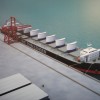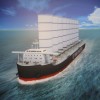Next-gen cargo ships could use 164-foot sails to lower fuel use by 30%
13:23 April 24, 2012

Depiction of a cargo ship equipped with the Wind Challenger Project system of sails
Of the world's nearly 45,000 cargo ships, many burn a low-grade bunker fuel in their engines and produce pollution equivalent to millions of automobiles. To help reduce that toxic load and keep the price of shipping freight reasonable, engineers at the University of Tokyo (UT) and a group of collaborators have designed a system of large, retractable sails measuring 64 feet (20 m) wide by 164 feet (50 m) high, which studies indicate can reduce annual fuel use on ships equipped with them by up to 30%.
"Using today's technology, it's possible to make big sails, and to control them automatically," UT professor Kiyoshi Uzawa told DigInfo. "Also, navigation technology includes networked maritime information and weather forecasting, so ships like this can travel safely. Using wind energy, as in old-fashioned sailing ships, is actually feasible."
Each five-segment collapsible sail, estimated to cost about US$2.5 million, will be hollow and constructed of durable, lightweight aluminum and fiber-reinforced plastic. Similar in shape to an aircraft wing in cross section, the sails can be positioned independently of one another to maximize thrust and, while at anchor or in bad weather, can telescope down in what is known as "vertical reefing."
Uzawa anticipates that, with basic research completed, the Wind Challenger Project (WCP) group will be able to consider construction of a reduced-size prototype in the next few years to fully prove the concept. If all goes as planned, sea trials could begin as soon as 2016. If results from scale model wind tunnel tests and computer simulations bear out in the real world, he believes the sails could pay ultimately for themselves in five to ten years.
Due to the varying nature of cargo vessels, it seems likely that the WCP technology will be better suited for low-slung bulk material ships (ore, grain, oil) than for sea container ships, say, which stack freight high above deck. The group is not short on innovation, however, so it'll be interesting to see how that issue is approached.
It appears that a new era of tall, greener ships could be just over the horizon.
Source: DigInfo via Akihabara News
Check out the DigInfo video below to learn more about the new sails.



